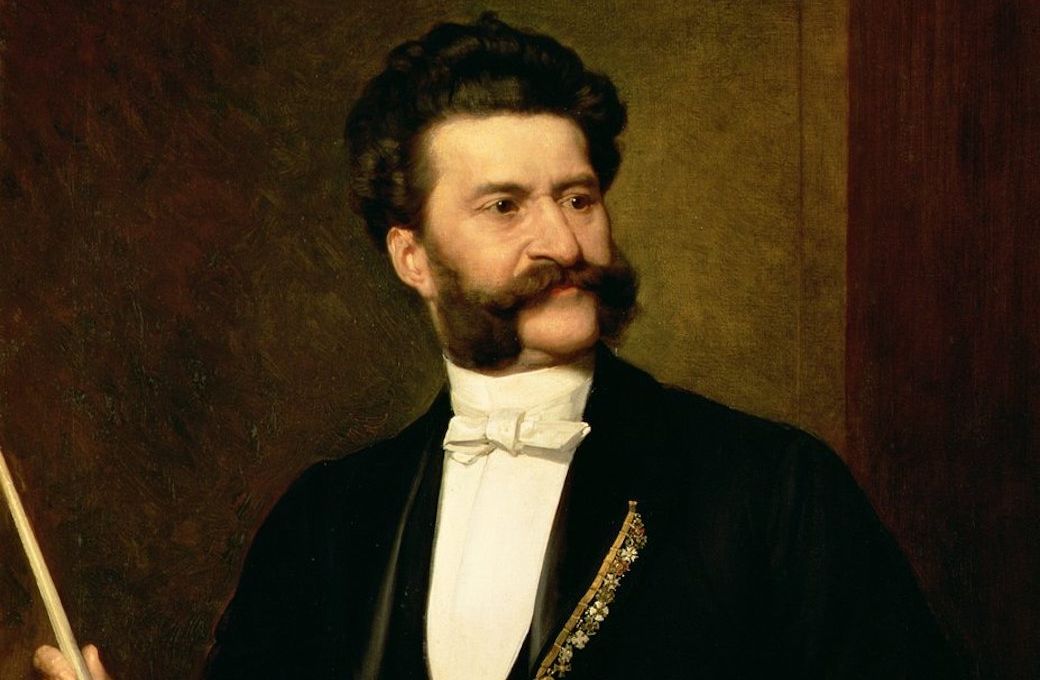Johann Strauss II, “the Waltz King” was born in Vienna on 25th October 1825. Music ran in the blood. His father, Johann Strauss (1804-49) was a composer, famous for his light music – waltzes, polkas and galops – dances which he helped popularise. However, Strauss Snr, a strict disciplinarian, did not wish his son to enter the music profession and young Johann began his career as a bank clerk.

Nevertheless, as a child Johann studied the violin secretly with the leader of his father's orchestra, Franz Amon. When his father found out, he gave his son a whipping, vowing that he was going to beat the music out of the boy. After his parents divorced, Johann’s mother, Maria Anna, did all she could to promote her son’s musical endeavours. In 1844 Strauss formed his own dance band, recruiting his members at the Zur Stadt Belgrad tavern. They initially performed at Dommayer's Casino, playing Strauss’ own music. During the 1848 uprisings, Strauss sided with the revolutionaries and was even arrested for playing La Marseillaise. His father, a staunch monarchist, composed his Radetzky March, dedicated to the Habsburg field marshal Joseph Radetzky, in retaliation.
When his father died in 1849, Strauss incorporated his ensemble into his father’s orchestra and its success took them on international tours to Russia and England. In America, he conducted concerts in New York City and Boston. Eventually, his younger brothers Josef and Eduard, also composers, took over the leadership of the orchestra so that Johann could spend more time writing dance music, which was all the rage. He also composed for the stage, completing 15 operettas, almost all of which premiered at the Theater an der Wien.
Strauss married three times: Henrietta “Jetty” Treffz, a singer (d.1878); the actress Angelika Dittrich (divorced 1882); and Adele Deutsch. Johannes Brahms was a friend and staunch admirer of Strauss. When Adele asked Brahms to autograph her fan, Brahms inscribed a few bars from The Blue Danube, writing underneath, “Unfortunately, NOT by Johannes Brahms”!
1An der schönen blauen Donau, Op.314
The moment I hear the famous gently rising triad played by the horns, my heart explodes. I’m not normally one for cheesy or romantic gestures, but I grew up in Dürnstein, arguably the most beautiful village along the Danube – watch out for it at the next New Year’s Concert – and the sound of the Donauwalzer brings me back to my carefree childhood, skimming stones on the Danube and dipping my feet into the cold water. Strauss composed two versions, one for male choir and orchestra, written to rather satirical lyrics (Austria having just lost a war with Prussia), and one for orchestra only which premiered on 10th March 1867. Today, the waltz is synonymous with Austrian culture and, when conducted by Willi Boskovsky, everything feels just right.[ES]
2Die Fledermaus
The problem with playing practical jokes is: payback. In Die Fledermaus (The Bat), which premiered at Theater an der Wien in 1874, Dr Falke gets his revenge on his pal Gabriel von Eisenstein, who once played a prank on him which ended up with Falke abandoned in the middle of the city, drunk, dressed in a bat costume. Falke’s elaborate revenge ropes in Eisenstein’s wife, his maid, a Russian prince and a prison governor. It’s a riotous farce, packed with great tunes, and when Eisenstein is found out, he blames it all – naturally – on the effects of Champagne. Fledermaus rightly remains Strauss’ most popular operetta. [MP]
3Kaiserwalzer, Op.437
Johann Strauss II composed the waltz in 1889 for the opening of the Berlin concert hall Königsbau and originally intended to name it Hand in Hand to express the political ties between the Prussian and Austrian monarchies. Presumably at the instigation of his new Berlin publisher Fritz Simrock, the name was changed to Kaiserwalzer. This now referred to the two emperors, Wilhelm II and Franz Joseph I, who were political allies and pursued a common foreign policy. [ES]
4Rosen aus dem Süden, Op.388
For his waltz Roses from the South, Strauss borrowed two melodies from his operetta Das Spitzentuch der Königin (The Queen's Lace Handkerchief): the “Trüffel-Couplet” and the Act 2 romance “Wo die wilde Rose erblüht”. After a pensive introduction, the waltz gradually picks up speed through to a giddy close. It was first performed in a Sunday concert in November 1880 at the Musikverein, conducted by Johann’s brother, Eduard. Fun fact: it was to this music that Elisabeth taught me to waltz! (still very clumsy…) [MP]
5Unter Donner und Blitz, Op.324
Thunder and Lightning is probably Strauss’ most famous Polka schnell, a quick dance where you have to be light on your feet. Unter Donner und Blitz, depicting a vigorous summer thunderstorm, was composed for a carnival ball in 1868, premiered in the Dianabad-Saal in Leopoldstadt. It’s a favourite at the New Year’s Concert and is sometimes inserted as interlude music in Act 2 of Die Fledermaus. [MP]
6Geschichten aus dem Wienerwald, Op.325
A couple of fun facts to begin with: Strauss’ waltz Geschichten aus dem Wienerwald has one of the longest introductions (119 bars!), it’s only one of six waltzes that feature the zither (as part of said introduction), and is a sequence of five waltzes. At the time of the premiere in 1868, the waltz had long since evolved from a disreputable village dance into a highly respected ballroom dance so Strauss chose a name reminiscent of the dance’s origins in the folk music of the Vienna Woods. [ES]
7Wiener Blut, Op.354
Here, the waltz does not draw on music from an operetta; instead, it was the title of the waltz that inspired the 1899 operetta, which is essentially a ‘juke box musical’ drawn from the ailing Strauss’ published works. The waltz was composed in 1873 and was written for a royal wedding, that of Archduchess Gisela Louise Maria, daughter of Franz Joseph I and Empress Sissi, to Prince Leopold of Bavaria. Its premiere was also significant because it marked the first time that Strauss conducted the Wiener Philharmoniker, which for many years had tried to distance itself from playing light music. [MP]
8Wo die Zitronen blühen, Op.364
This waltz is essentially a postcard from Italy, radiating Mediterranean warmth. Strauss composed it when he was on tour there with the Langenbach Orchestra in 1874 and it had its premiere in Turin, where it premiered under the title Bella Italia. However, he renamed it Wo die Zitronen blühen after a line from Goethe's novel Wilhelm Meisters Lehrjahre where Mignon sings: “Kennst du das Land, wo die Zitronen blühn?” (Do you know the land where the lemons blossom?). [MP]
9Der Zigeunerbaron
Take the War of the Austrian Succession (1740–1748), or the Austro-Hungarian Compromise of 1867 – librettist Ignaz Schnitzer might have muddled up a few dates – heirs (presumed missing), long-lost treasures and main characters repeatedly falling in love with the “wrong” people, and you have the perfect setting for an operetta. Although Strauss achieved great success with the premiere on 24th October 1885 at the Theater an der Wien, it took another 25 years to fulfil his dream of having Der Zigeunerbaron performed on an actual opera stage when both the Semperoper in Dresden and the Wiener Staatsoper added the operetta to their schedules. [ES]
10Perpetuum Mobile, Op.257
Strauss’ little Musical Joke from 1861 goes on and on and on and on and on… “and we could still do it again” (Willi Boskovsky). [ES]


